
Hans Ledwinka's stay at Tatra was cut short after the war in 1945 when he was accused of collaboration with the Nazis and promptly imprisoned until 1951. After release he moved to Austria and then to Munich, Germany where he remained until his death in 1967. A shiny silver T87, donated by him, is on display there in the Deutches Museum.
In 1946 the company was nationalized and its name was reverted to Tatra
(Tatra narodni podnik to be precise). Czechoslovakia had fallen under Soviet control and the Russians dismantled much of the production machinery at Koprivnice, making the task of building automobiles more difficult for some years.

The position of chief designer at Tatra was filled by Julius Mackerle, who had already been thinking about a replacement for the highly successful T57b with many elements of the T87 and T97. And so the design phase proceeded and resulted in the prototype T107, which was later deemed to have too complicated a construction. This was rectified and led to the Tatraplan (model T600), which was introduced in October the following year and put into production in 1948.
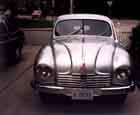 John Long's 1950 Tatraplan
John Long's 1950 Tatraplan
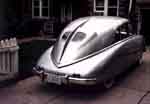 (G.C.)
(G.C.) (E.P.)
(E.P.)
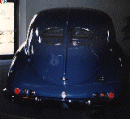 another T600
another T600

The Tatraplan was roughly the size of the T97 and its body shape and dimensions were largely based on the T97's with the stabilizing fin reduced in size and the location of the air intakes changed. A significant improvement over the pre-war streamlined models was the almost equal weight-distribution of 45% at the front and 55% at the rear which meant much more predictable handling. The T600 was powered by a 50 bhp 1.95-litre air-cooled OHV (this time with chain driven cams) 4-cylinder rear-mounted engine and had an identical top speed to that of the old T97 at 130 km/h. The independent suspension system used was a bit different from previous practices, composed of leaf springs at front and torsion bars coupled with the familiar swing-axles at the rear. The Tatraplan's great ride quality was typically Tatra, directional stability was phenomenal, and wind noise was very low.
 Tatraplan cabriolet
Tatraplan cabrioletA few other automobiles based on the Tatraplan were also built, notably the two-seaters T601 Tatraplan Monte Carlo (aluminum bodied) and the 180 km/h T602 Tatraplan-Sport and a convertible prepared by the Czech coachbuilder Sodomka. Tatra produced the Tatraplan until 1951 when the Czech Skoda company took up production of it for export only.
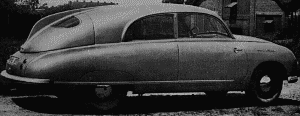 T601
T601
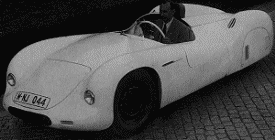 T602
T602
The world was reminded of the old Tatra T87 when, beginning in 1947, two
Czech writers, Hanzelka and Zikmund, took one on a gruelling 1290-day journey
across the African and South American continents where using an air-cooled
engine is very advantegous.
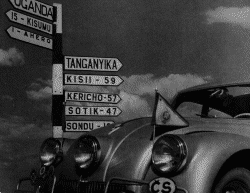
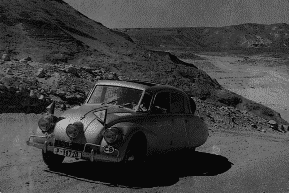
Nineteen-forty-nine (1949) was a very notable year. Four Tatraplans experienced a
sweeping 1-2-3-4 victory at that year's Alpine Trials in Austria.
In 1951 serial production of passenger cars by Tatra was interrupted for
a few years. The government instructed the company to concentrate on trucks,
at which they succeeded well, and the occasional big luxury car. During those years appeared the T607 Monopost (single seater), a mid-engined racing car powered by a 161
bhp 2.35-litre V8 and capable of 208 km/h. Later the capacity of its engine
was increased to create the 181 bhp T607-2 which attained a speed of 215
km/h.
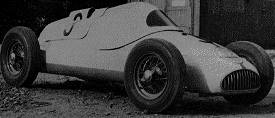
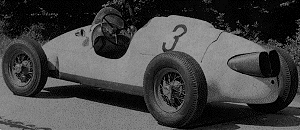 T607
T607

T603 from May '58 Czechoslovak Motor Review cover, (R.D.)
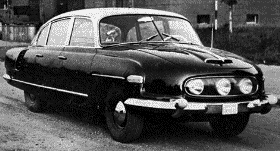 The manufacture of Tatra automobiles was moved from Koprivnice to the near-by town of Pribor before serial production was re-started in 1957. The first Tatra automobile to clear the gates at Pribor was the bulbous T603, fitted with 3 headlights covered by a glass shield.
The 160 km/h T603 was a big 5/6 passenger sedan initially
powered by a new 2.5-litre V8 engine with an output of 94 bhp. At 2750mm, its
wheelbase was similar to the Tatraplan's but its length was quite a bit
greater and so there was a substantial amount of overhang at the ends. A few
years after appearing a T603 received an award for its looks in West Germany.
The manufacture of Tatra automobiles was moved from Koprivnice to the near-by town of Pribor before serial production was re-started in 1957. The first Tatra automobile to clear the gates at Pribor was the bulbous T603, fitted with 3 headlights covered by a glass shield.
The 160 km/h T603 was a big 5/6 passenger sedan initially
powered by a new 2.5-litre V8 engine with an output of 94 bhp. At 2750mm, its
wheelbase was similar to the Tatraplan's but its length was quite a bit
greater and so there was a substantial amount of overhang at the ends. A few
years after appearing a T603 received an award for its looks in West Germany.
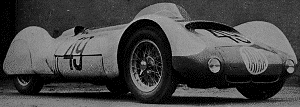 T605
T605The T605 340 kg 2-seater racing car, enveloped in a 2-piece aerodynamic body, also came that year. It was propelled by a tiny 0.6-litre 2-cylinder rear-mounted engine giving a good 54 bhp and a 168 km/h top speed.
After a production of 5992, the T603 was replaced by the T2-603 in 1964. Externally it differred from the original only in details, most notable being the change to a more conventional 4 headlight configuration up front. Top speed also dropped down to 150 km/h due to a slight engine capacity decrease. Until its demise in 1975 a good 14450 copies were made and so total T603 production exceeded 20,000.
 (C.W.)
(C.W.)
 T2-603
T2-603

Nineteen-sixty-six (1966) yet again demonstrated the excellence of Tatra design. Three (3) specially prepared T2-603B5s (143 bhp and a top-speed of 195 km/h) entered the 84 hour Marathon de la Route endurance race against some formidable competitors. The result was staggering: a 1-2-3 victory in the 2500cc-and-under class and 3rd and 5th places overall for 2 of them. Pretty remarkable for a rather massive 4-door sedan.
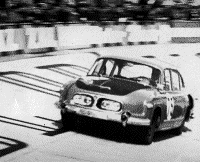 at the Marathon
at the MarathonLater that year a single prototype referred to as T2-603X was constructed. It was based on the mechanicals of the T2-603 and had a rather modern looking body styled by the Italian SI design house. This excercise led to the next Tatra model, the T613, of quite a different appearance.
 T2-603X prototype (C.W.)
T2-603X prototype (C.W.)
